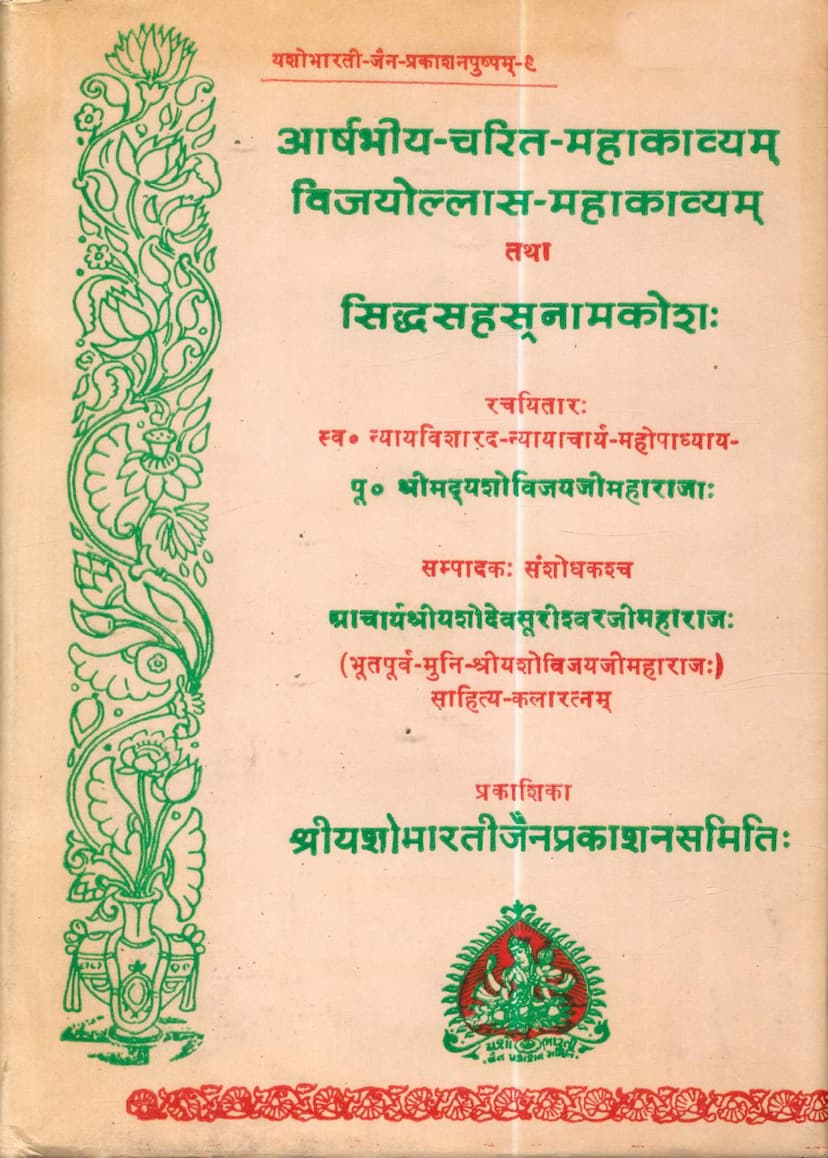Arshbhiyacharit Vijayollas Tatha Siddhasahasra Namkosh
Added to library: September 1, 2025

Summary
This summary provides a comprehensive overview of the Jain text "Arshbhiyacharit Vijayollas tatha Siddhasahasra Namkosh" by Yashovijay, based on the provided catalog link and page excerpts.
Book Title: Arshbhiyacharit Vijayollas tatha Siddhasahasra Namkosh Author: Shrimad Yashovijayaji Maharaj (also known as Muni Shri Yashovijayaji Maharaj, and later as Acharya Shri Yashodev Surishwarji Maharaj in his editorial capacity) Publisher: Shri Yashobharati Jain Prakashan Samiti, Bombay Publication Details:
- Series: Shri Yashobharati Jain Publication Series-9 (as per Page #4)
- First Edition: Copies: 500
- Price: Rs. 20.00
- Vikram Samvat: 2034
- Vir Samvat: 2504
- A.D.: 1978 (as per Page #5, though Page #3 states 1976)
- Printers: Nirupama Printers, New Delhi
Core Content:
The book contains three significant works by the renowned Jain scholar and poet, Shrimad Yashovijayaji Maharaj:
-
Arshbhiyacharit Mahakavyam (आर्षभीय-चरित-महाकाव्यम्): This is an epic poem detailing the life and teachings of the first Jain Tirthankara, Bhagwan Shri Rishabhdev. The excerpt indicates that it is largely a philosophical and allegorical work, with some historical elements. Unfortunately, the text is incomplete, with only the first four chapters (Sargas) available, and the fourth chapter is also incomplete. The poem is noted for its eloquent language, adherence to classical epic conventions, and exploration of philosophical themes through a narrative structure.
-
Vijayollas Mahakavyam (विजयोल्लास-महाकाव्यम्): This is another epic poem, likely a narrative of triumph or spiritual victory. The provided excerpts show the first two chapters (Sargas), and the second chapter is incomplete. It appears to focus on beautiful descriptions and the unfolding of a significant event or life. The text is praised for its poetic artistry, use of metaphors, and skillful employment of various Sanskrit meters.
-
Siddhasahasra Namkosh (सिद्धसहस्रनामकोशः): This is a treasury of names dedicated to the Siddhas, liberated souls in Jainism. The book compiles one thousand (or more precisely, 1008) names, likely extolling their virtues, powers, and liberated state. This work follows the Jain tradition of compiling Sahasranama (thousand names) for veneration and spiritual benefit. The text is presented in a structured manner with ten chapters (Prakasha/Shataka). The preface highlights the unique focus on Siddhas as opposed to the more common focus on Tirthankaras in previous Jain Sahasranama works.
Key Aspects and Themes:
- Author's Expertise: Shrimad Yashovijayaji Maharaj was a multifaceted scholar, described as a "Nyaya-Visharada" (expert in logic), "Nyayacharya" (teacher of logic), and "Mahopadhyaya" (great teacher). He was well-versed in various philosophical systems (Shad-darshanavetta) and excelled in logic, poetry, and religious discourse.
- Editorial and Publication Efforts: The publication of this book is a significant undertaking by the Shri Yashobharati Jain Prakashan Samiti. The "Prakaskiya Nivedan" (Publisher's Note) on pages 7-9 details the inspiring efforts to publish the works of Yashovijayaji Maharaj, acknowledging the financial support from the Jain community and the dedicated editorial work of Muni Shri Yashovijayaji Maharaj (the current Acharya Shri Yashodev Surishwarji Maharaj). Dr. Rudradev Tripathi played a crucial role in editing and compiling these works.
- Literary Merit: The poems are lauded for their sophisticated Sanskrit, adherence to classical poetic meters (chandas), rich use of figures of speech (alankaras), and philosophical depth. They aim to convey spiritual messages through elegant narratives and descriptions.
- Biographical Information: Pages 12-25 provide a detailed biographical sketch of Shrimad Yashovijayaji Maharaj, tracing his life from birth in Gujarat, his early inclination towards spiritual pursuits, his rigorous education (including studies in Kashi), his mastery of various disciplines, his scholarly debates, and his attainment of prestigious titles. It also highlights his prolific writing career and his contributions to Jain literature.
- Focus on Jain Principles: The works, particularly the epic poems, are rooted in Jain philosophy, emphasizing themes of dharma, non-violence, detachment, spiritual liberation, and the exemplary lives of Tirthankaras.
- Preservation of Knowledge: The publication signifies a dedicated effort to preserve and disseminate the valuable literary and spiritual heritage left by Shrimad Yashovijayaji Maharaj. The efforts highlight the importance of making these ancient texts accessible to a wider audience through careful editing and publication.
- The "Siddhasahasra Namkosh": This work is particularly significant as it focuses on the liberated souls (Siddhas), whose names are chanted for spiritual merit and well-being. The preface emphasizes the importance of name-chanting (namasmaran) in Jain tradition and explains the structure and purpose of this compilation.
- Manuscript Information: Pages 26-28 provide photographic reproductions of manuscripts for "Arshbhiyacharit" and "Siddhasahasra Namkosh," offering a glimpse into the original form of these texts and the scholarly effort involved in their preservation.
In essence, "Arshbhiyacharit Vijayollas tatha Siddhasahasra Namkosh" is a scholarly compilation that brings together two epic poems and a significant devotional text by one of Jainism's most influential figures, Shrimad Yashovijayaji Maharaj. The book stands as a testament to his profound scholarship, literary genius, and unwavering dedication to the Jain faith and its propagation.